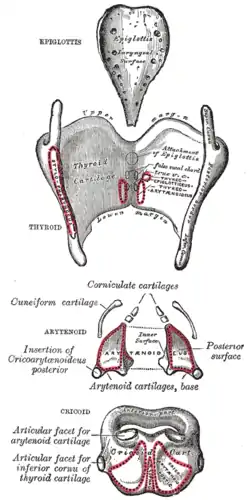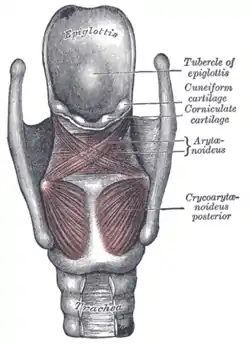Posterior cricoarytenoid muscle
The posterior cricoarytenoid muscles are small, paired intrinsic muscles of the larynx that extend between cricoid cartilage to the arytenoid cartilages in the larynx.
| Posterior cricoarytenoid | |
|---|---|
 Muscles of larynx. Side view. Right lamina of thyroid cartilage removed. | |
| Details | |
| Origin | posterior part of the cricoid |
| Insertion | posterior surface of muscular process of the arytenoid cartilage |
| Nerve | recurrent laryngeal nerve branch of the vagus nerve (CN X) |
| Actions | abducts and laterally rotates arytenoid cartilage, pulling vocal ligaments away from the midline and forward and so opening rima glottidis |
| Antagonist | lateral cricoarytenoid muscle |
| Identifiers | |
| Latin | Musculus cricoarytaenoideus posterior |
| TA98 | A06.2.08.004 |
| TA2 | 2196 |
| FMA | 46576 |
| Anatomical terms of muscle | |
Structure
Origin and insertion
The posterior cricoarytenoid originates from the posterior surface of the posterior quadrate lamina of the cricoid cartilage. It inserts onto the muscular process of the arytenoid cartilage.[1] Its distinct medial and lateral bellies insert onto opposite surfaces of the muscular process.[1]
Nerve supply
The posterior cricoarytenoid muscles are supplied by the anterior division of the recurrent laryngeal nerve, a branch of the vagus nerve (CN X).[2][3] Sometimes, different parts of the muscle (such as the medial and lateral muscle bellies) are supplied by separate branches.[2] This may vary between 1 and 6 branches, usually 2 or 3.[3] These may connect within the muscle.[3]
Function
The posterior cricoarytenoid muscles are the only muscles to open the vocal cords.[4] By rotating the arytenoid cartilages laterally, these muscles abduct the vocal cords.[4][5] This opens the rima glottidis.[5] : 9 This is important in breathing and speech.[4] Their action opposes the lateral cricoarytenoid muscles.
Clinical significance
Paralysis of the posterior cricoarytenoid muscles may lead to asphyxia, as they are the only laryngeal muscles to open the vocal cords (allowing breathing).[6] Denervation leads to a slow fibrosis that worsens over many months.[7]
Additional images
 The cartilages of the larynx. Posterior view.
The cartilages of the larynx. Posterior view. Muscles of larynx. Posterior view.
Muscles of larynx. Posterior view. Muscles of the larynx, seen from above.
Muscles of the larynx, seen from above. Dissection of the muscles of the palate from behind.
Dissection of the muscles of the palate from behind. Posterior cricoarytenoid muscle
Posterior cricoarytenoid muscle Posterior cricoarytenoid muscle
Posterior cricoarytenoid muscle Posterior cricoarytenoid muscle
Posterior cricoarytenoid muscle
See also
References
- Bryant, Nancy Jones; Woodson, Gayle E.; Kaufman, Kenton; Rosen, Clark; Hengesteg, Arne; Chen, Naidy; Yeung, Daniel (1996-12-01). "Human Posterior Cricoarytenoid Muscle Compartments: Anatomy and Mechanics". Archives of Otolaryngology–Head & Neck Surgery. 122 (12): 1331–1336. doi:10.1001/archotol.1996.01890240039009. ISSN 0886-4470.
- Sanders, Ira; Wu, Bei-Lian; Mu, Liancai; Biller, Hugh P. (1994). "The innervation of the human posterior cricoarytenoid muscle: Evidence for at least two neuromuscular compartments". The Laryngoscope. 104 (7): 880–884. doi:10.1288/00005537-199407000-00019. ISSN 1531-4995.
- Maranillo, Eva; León, Xavier; Ibañez, Marta; Orús, César; Quer, Miguel; Sañudo, José Ramón (2003). "Variability of the Nerve Supply Patterns of the Human Posterior Cricoarytenoid Muscle". The Laryngoscope. 113 (4): 602–606. doi:10.1097/00005537-200304000-00004. ISSN 1531-4995.
- Brancatisano, T. P.; Dodd, D. S.; Engel, L. A. (1 October 1984). "Respiratory activity of posterior cricoarytenoid muscle and vocal cords in humans". Journal of Applied Physiology. 57 (4): 1143–1149. doi:10.1152/jappl.1984.57.4.1143. ISSN 8750-7587.
- Hydman, Jonas (2008). Recurrent laryngeal nerve injury. Stockholm. ISBN 978-91-7409-123-6.
- The Arytenoid Cartilages - a clinical overview. 2002, Dr. C Kay et al. Thorne Publishing (C)
- Zealear, David L.; Hamdan, Abdul-Latif; Ratney, Cheryl L. (1994-10-01). "Effects of Denervation on Posterior Cricoarytenoid Muscle Physiology and Histochemistry". Annals of Otology, Rhinology & Laryngology. 103 (10): 780–788. doi:10.1177/000348949410301007. ISSN 0003-4894.
External links
- Atlas image: rsa4p2 at the University of Michigan Health System
- lesson11 at The Anatomy Lesson by Wesley Norman (Georgetown University) (larynxmuscles)